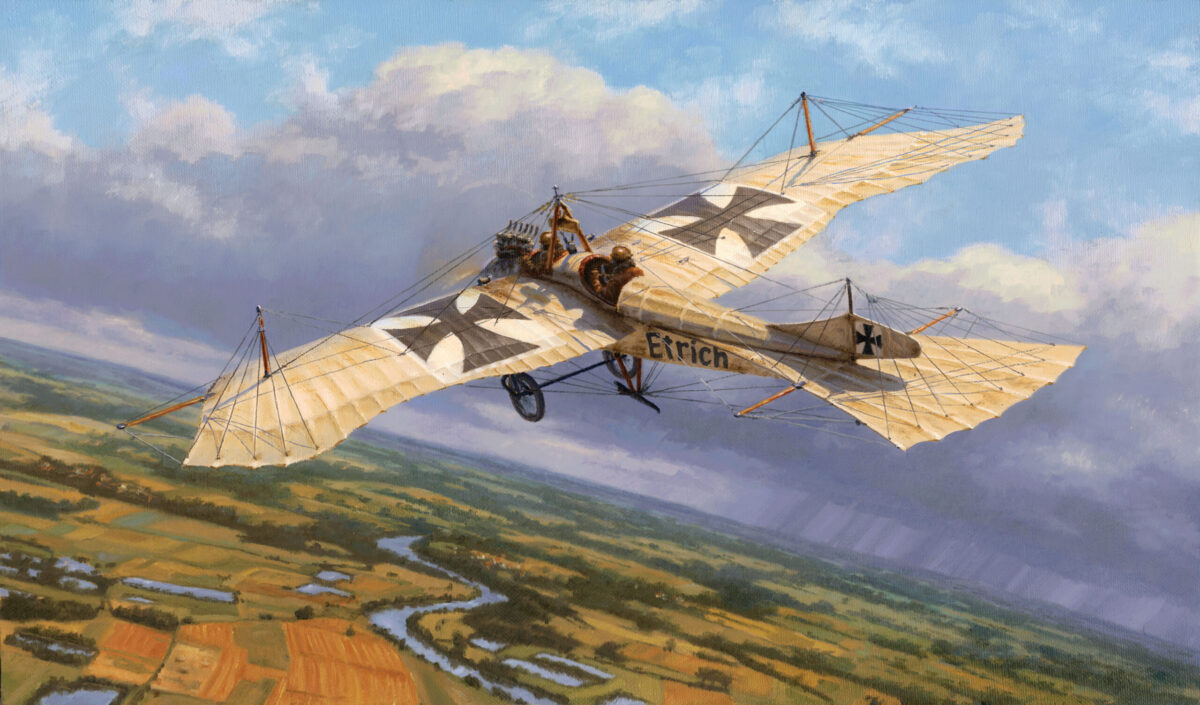Between 1910 and 1915, the aviation scene in Central Europe was dominated by a series of graceful, birdlike airplanes collectively referred to as Tauben (literally, “pigeons,” though English-speakers preferred to call them “doves”). Most were monoplanes with wings braced by a combination of wires and a girder-like structure underneath the wings called a Brücke (“bridge”). Their most characteristic feature was reflexed or washed-out wingtips that curved upward at the trailing edge, endowing them with inherent stability. In a time when aircraft were usually difficult and often dangerous to control, that alone made the Taube both popular and famous.
Germany built and flew the most Tauben before and during the first year of World War I. Indeed, by the end of 1914, Allied troops tended to use the term “Taube” for every German airplane they saw. Despite its Teutonic association, however, the Taube design originated in Austria-Hungary. And in spite of its avian shape, the Taube’s evolutionary process literally grew from a seed.
The Etrich behind the Taube was born in Trutnov, Bohemia—then part of the Austro-Hungarian Empire—on December 25, 1879. He received his father’s name, Ignaz Etrich, but came to be called Igo. In 1895 the Etrichs, who owned linen mills in two Bohemian towns, became interested in the glider experiments of German aviator Otto Lilienthal. Ignaz sent his son to school that year to learn the fundamentals of aviation, and then sent him to the Technical College in Leipzig.
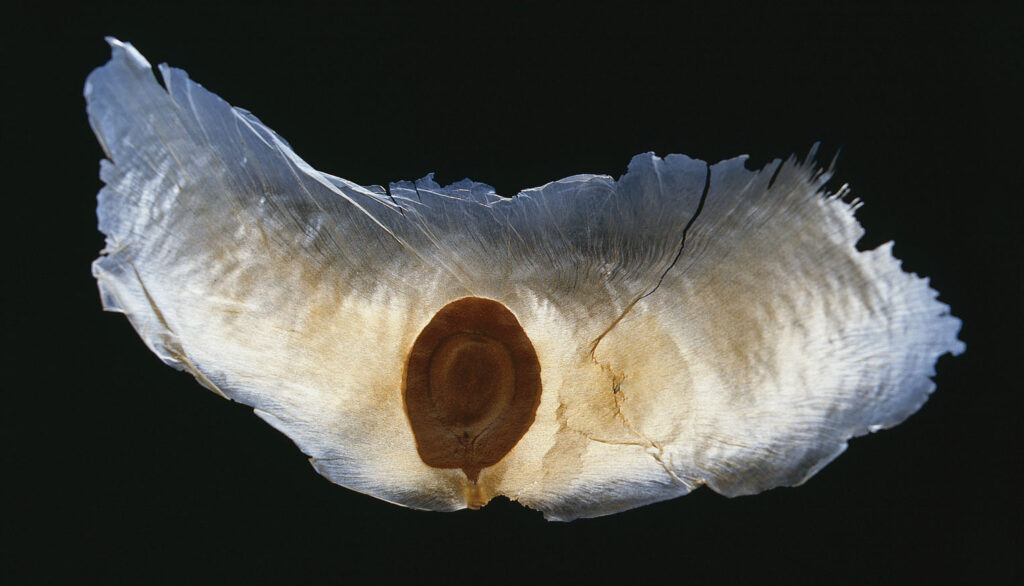
In August 1896, Lilienthal was fatally injured in a glider accident. Determined to continue his experiments, the Etrichs purchased two gliders in Berlin, but in 1898 they began work on their own design. It featured a welded steel-tube frame, a tall three-wheeled undercarriage and a pilot’s seat, but the glider proved heavy and unstable. During a test flight in 1901, it crashed on the runway, injuring Igo. Disappointed, Ignaz Etrich returned to managing his linen factory, but in 1903 he hired Franz Xaver Wels, a fencing teacher who built box kites and monoplane flying models, to assist his son with the gliders.
The most influential aeronautical literature Etrich and Wels found was a small 50-page book published in March 1897 by a professor from Hamburg, Friedrich Ahlborn. Entitled Über die Stabilität der Flugapparate (On the Stability of Flying Machines), it criticized Lilienthal’s gliders, which depended on the pilot’s skill to stay in the air. Ahlborn concluded that practical flight required a self-stabilizing aircraft. He also claimed that the shape necessary to achieve auto-stability already existed, in the form of the seed of a Javanese vine, Zanonia macrocarpa (later reclassified as Alsomitra macrocarpa).
In January 1904, Wels and the Etrichs contacted Ahlborn, who sent them a Zanonia seed. The seed itself lay in the axis of two winglike appendages, very near their leading edges. The trailing edges of the “wings” were reflexed, or curved upward. The seed’s natural design allowed it to glide clear of its parent plant before taking root, and it inspired Etrich to develop the concept for a man-carrying flying machine based on the same shape.
Using paper and glue, the Etrichs and Wels began to construct larger and larger models, then began work on a tailless glider with bamboo wings, covered with cellulose-doped fabric. Sometime in mid-1904 the glider astonished spectators—and its constructors, for that matter—when it sailed along for 1,640 feet before gently touching down for a perfect landing. Etrich’s glider went on to make hundreds of unmanned flights, proving Ahlborn’s auto-stability theory.
On March 3, 1905, Etrich applied for an Austrian patent on his “Zanonia wing.” Patent No.23465, granted on October 1, covered the wing’s geometry as well as other details, such as the ratio between two wing-mounted contrarotating pusher propellers and the engine that was to power them—even though none of this had been installed. The patent also included a crude means of varying the pitch of Etrich’s differential-thrust propellers. Igo Etrich now installed a 3½-hp Laurin und Klement motorcycle engine on the glider to power two propellers. When he tested the Motor-Gleiter (motor-glider), however, he found it too unstable to fly.
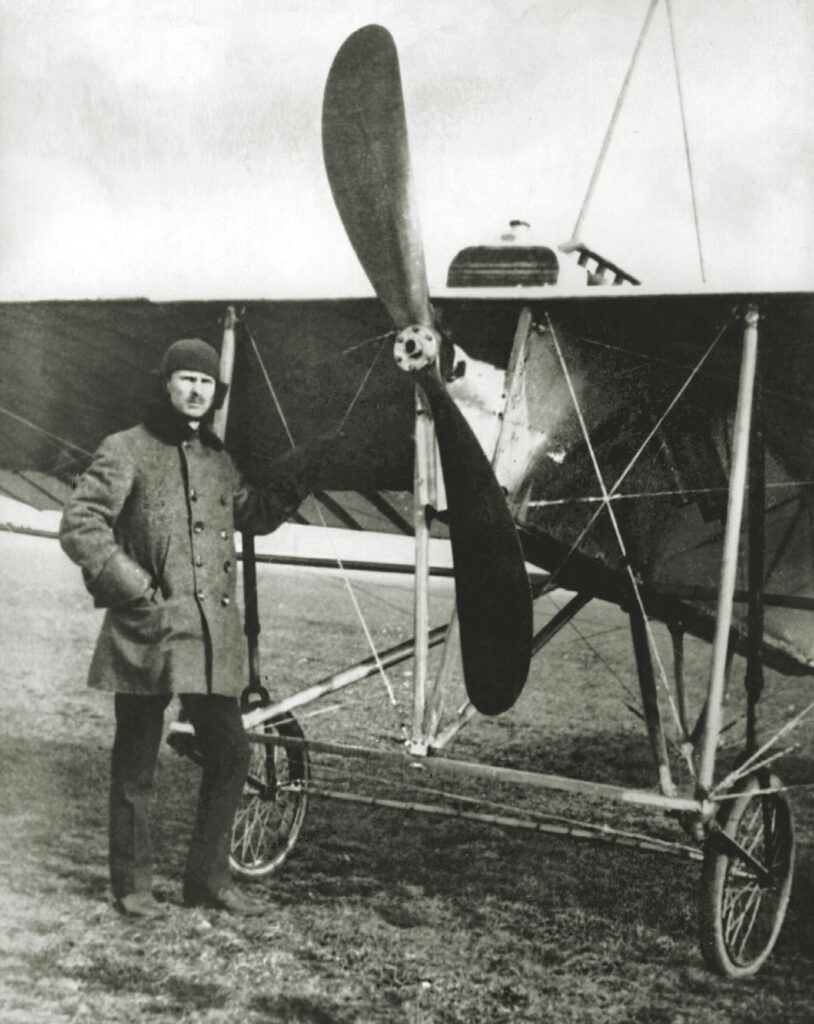
Etrich and Wels continued work on a man-carrying aircraft. With the addition of two vertical pylons and buttressing cables to stiffen the wings, the glider flew on October 2, 1906, with a 154-pound sandbag in place of a pilot. Following three flawless unmanned flights, Wels got into the cockpit. He hoped to control the flying machine by leaning, but that proved neither possible nor, in this case, necessary. The tailless wing skidded to a perfect landing after a flight of 492 feet. A second flight increased the distance to 590 feet, and a third reached 850.
Etrich built a second Motor-Gleiter in the winter of 1906-1907. He originally intended to use a 50-hp Antoinette engine to power a single chain-driven pusher propeller, but Wels claimed that would be “too much power” and recommended a 24-hp Antoinette instead. Not entirely satisfied with the design, Etrich mounted a rectangular elevator in front of the wing, operated by a pair of foot pedals. One hand wheel warped the wingtips for lateral control, while another adjusted the propeller’s pitch. For all that work, however, the Motor-Gleiter never flew. The 24-hp engine on which Wels had insisted proved insufficient to get it off the ground, causing a growing friction between him and Etrich.
At Wels’ suggestion, early in 1908 Ignaz Etrich bought his son a workshop in Vienna. At about that same time the Etrich Textile Company got a substantial contract from Russia and Igo spent the next six months establishing a mill there. Upon returning to Vienna, he discovered that Wels had modified the Motor-Gleiter into a tailless wing again, with the front stabilizer removed and the engine driving a tractor propeller by means of an extension shaft. Two pylons anchored the supporting guy wires, and the pilot was moved aft, between two large wheels. In this form, the plane was given several designations, such as Etrich I, Sperling (sparrow) and Praterspatz (references to the sparrows that inhabited Vienna’s Prater Park, where flight testing was conducted). The engine was still too weak, and Etrich reported that “flights were without results because the apparatus was directionally unstable…and ran into trees!” As one consequence of the failures, Etrich moved his experiments outside Vienna, to an airfield at Wiener Neustadt.
In the fall of 1908 Etrich sent Wels to France to obtain a “stronger” engine and also to appraise Orville and Wilbur Wright’s Flyer, which Wilbur had been demonstrating in Paris. Wels was so impressed that after returning to Vienna he began work on a similar biplane using ailerons instead of the Wrights’ wing-warping system. When Etrich returned from Russia, he was incensed to learn that Wels had abandoned the Zanonia-seed concept against his wishes. He stopped work on the biplane, dismissed Wels on July 20, 1909, and replaced him with a fellow Bohemian, Karl Illner.
By this time, Etrich had concluded that his flying wings could not maintain their stability with engines installed. Therefore, in 1907 he gave his Etrich I a fuselage with triangular vertical stabilizers above and below a larger horizontal stabilizer. The airplane remained underpowered, so in October 1909 Etrich bought a 40-hp Clerget inline water-cooled engine that proved sufficient.
Somehow, amid all his aviation activity, Etrich found time for other pursuits—on November 23, 1909, he married Miss Louise Fink-Bartholomei. The honeymoon was brief, however, for six days later, with the Clerget installed in his revised aircraft, Etrich achieved his first real flight in it, traveling 2¾ miles at 43.5 mph at an altitude of 82 feet. In so doing, he was credited with designing and piloting the first Austrian airplane capable of sustained flight.
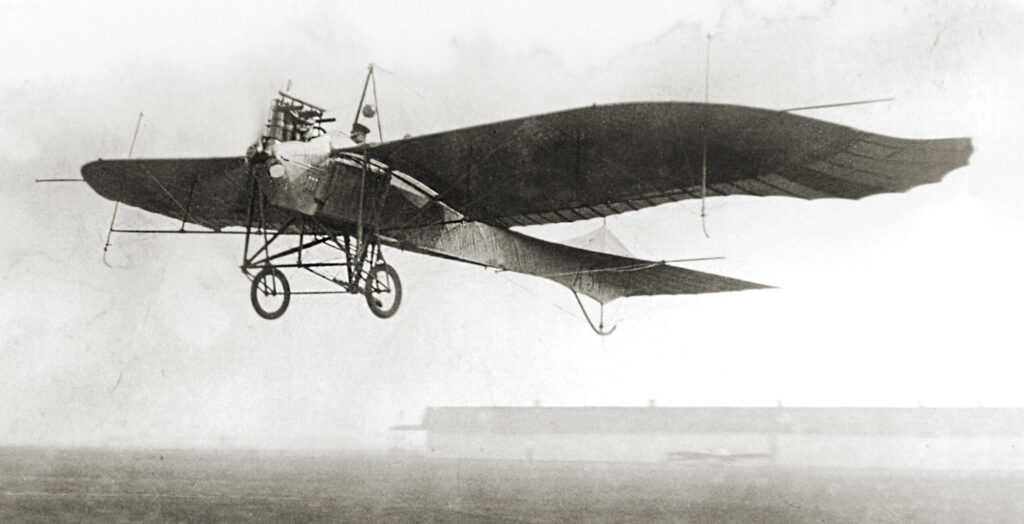
Toward the end of 1909, Etrich began construction of a completely new airplane. Dubbed Etrich II but also called the Taube—the first airplane to bear the name—it had a wingspan of 45 feet and was 34 feet long. The Clerget provided the power. This time, Etrich mounted the modified Zanonia wing on a slender fuselage with two tandem cockpits and a fan-shaped horizontal stabilizing surface, the end of which could be warped to serve as an elevator. A triangular vertical stabilizer and rudder sat above the horizontal stabilizer; in most later Taubes, a second such arrangement was installed beneath the stabilizer as well.
Testing began on April 10, 1910. The first takeoff happened so quickly that it startled Etrich, who consequently made a rough landing that damaged the landing gear and injured his back. Realizing that his clumsy reaction was largely due to the strain of designing and flying aircraft over the past several years, Etrich later remarked, “I now left all of the work to Illner.” Illner took the repaired Taube up for a short flight on April 20. The next day, he flew it for eight minutes, including “curves and eights.” Four days later, Illner made an official flight in the plane that earned him his pilot’s certificate—Austrian license No.3.
Almost immediately the Taube began setting records, starting with an endurance flight of 25 minutes on April 30. On May 15 the Taube broke all Austrian records by staying up at an altitude of 300 meters (984 feet) for one hour, eight minutes. Two days later Illner flew the 28 miles from Wiener Neustadt to Vienna in 32 minutes at altitudes ranging from 984 to 1,312 feet, then returned in 30 minutes. On the next day Etrich’s wife, Louise, went up as a passenger.
Igo Etrich followed his creation with a succession of refinements. Etrich III was also called the Möwe (seagull). Etrich IV was called a Taube and a license for its manufacture was sold to Viennese-born Edmund E. Rumpler in Germany. On July 7, 1910, Etrich licensed Camillo Castiglioni’s Motor-Luftfahrzeug Gesellschaft to build the engines and instruments for five Etrich IV Taubes, while Jacob Lohner & Co. in Vienna built the airframes. He subsequently sold licenses to various manufacturers in Russia, France, Britain and the United States, but of those countries, only France produced a single Taube. Italy bought two examples of Etrich X.
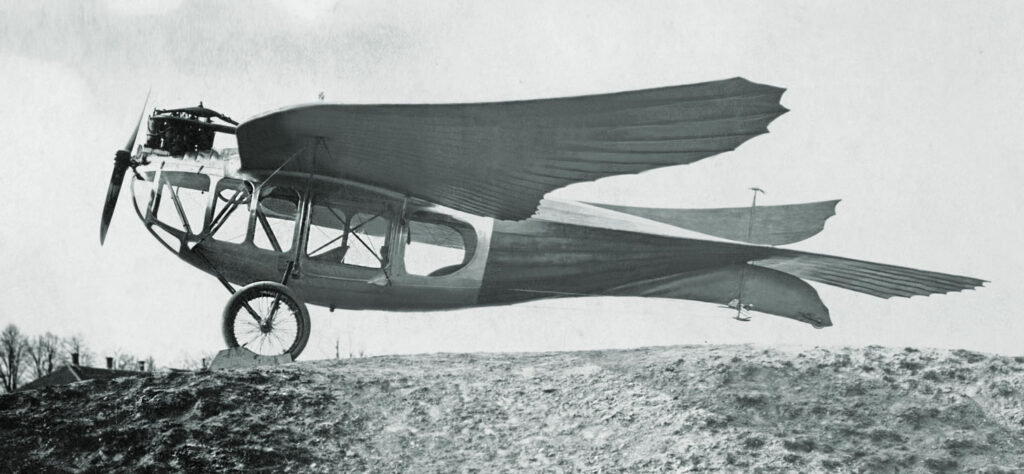
According to Etrich, his agreement with Rumpler stipulated that its aircraft were to be called Etrich-Rumpler Taubes, but Rumpler violated the deal, claiming that “although Etrich employed the right principles, Rumpler had to do a lot to make the Taube a practical aircraft.” Rumpler built his versions in Germany—where Etrich held no patents—and became the most prolific single manufacturer of Taubes. Other German companies, such as Gotha, Jatho, Jeannin, Harlan and Albatros, built Taubes of their own. Variations of the Taube were being built and exported to Italy, Russia, Spain, Britain and China.
Etrich touted the unique Etrich VII Limousin, built in Trutnov, as the world’s first airliner. The pilot and three passengers sat in tandem within a streamlined aluminum-braced fuselage, with Cellon windows providing a beautiful view for all. Drippings and noise from the engine probably made the interior less than pleasant, however, and in the interest of allowing the pilot to concentrate on his flying, his seat was later repositioned in an open cockpit behind the wing. On August 16, 1912, the Limousin set two world records when Austrian 2nd Lt. Heinrich Bier flew it with three passengers at a speed of 65.74 mph and, in a second flight that day, reached 69.44 mph with two passengers.
Edmund Rumpler built an enclosed Limousin of his own, which he exhibited at the Berlin Aero Show between April 3 and 14, 1912. Not quite as streamlined as Etrich’s creation, the Rumpler Limousin enclosed its pilot and passenger inside an aluminum-and-plywood cabin with four mica windows and a door for entry. Another difference between the two Limousins was that the pilot of Rumpler’s version had practically no forward visibility.
In 1912, Etrich set up factories in Germany but was disappointed by his failure to interest the Germans in his Limousin, or in an unusual three-seat design that he called the Schwalbe. The latter, powered by a 60-hp Austro-Daimler engine, had a scimitar-shaped wing and spars made of steel tube, but it had neither ailerons nor wing-warping. The Taubes’ stability notwithstanding, it is easy to guess why an airplane whose controls were limited to rudder and elevators would not appeal to pilots. Moreover, by that time the whole Taube concept, with the inherent drag-producing weaknesses of its design, was becoming obsolete.
Etrich built several more Taubes for his flying school in Johannisthal, Germany, in 1913. The first of them, bearing the German registration number D.2 and its builder’s name prominently displayed under the wing, made a publicity flight from Berlin to London, with interim stops in Paris and Brussels. Alfred Friedrich was the pilot and Etrich flew as a passenger for part of the journey, including its final landing at Hendon on September 12, 1913. During Friedrich’s aerial linking of capitals, the British government issued its first diplomatic air clearance to him, under the provisions of the Aerial Navigation Acts of 1911 and 1913. Replying to the question, “Object of Voyage,” Friedrich wrote: “Pleasure Trip!”
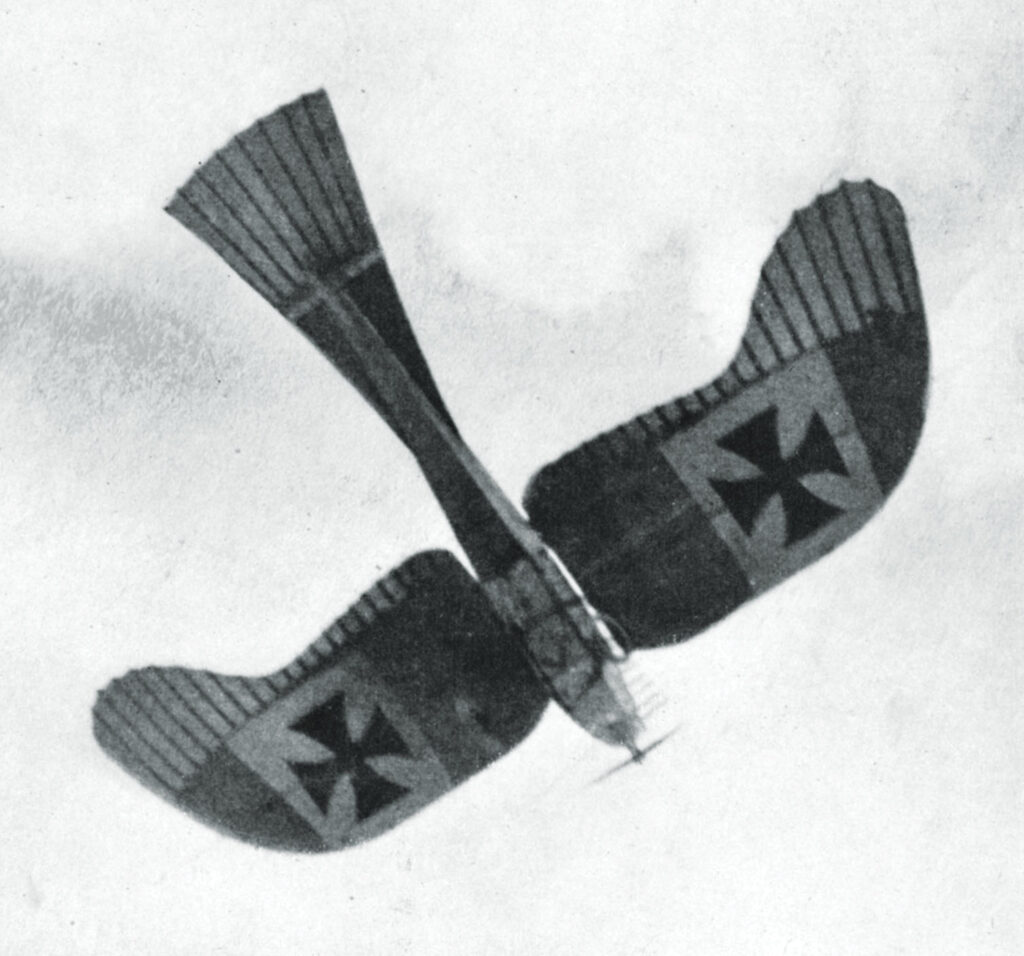
During 1913, Lohner and other Taube manufacturers tried to increase the speed of their aircraft by means of streamlining and more powerful engines, but such efforts only underscored the drawbacks in Etrich’s concept. By the end of 1912, the Imperial and Royal Austro-Hungarian Air Service realized that the Taube had reached the limits of its potential.
Given the records set by the stable, reliable Taube, it is small wonder, albeit ironic, that an airplane named after a dove would also establish several “firsts” in aerial warfare. When Italian forces invaded the Turkish-held North African provinces of Tripolitania and Cyrenaica on October 5, 1911, they brought with them a small collection of aircraft, including two Lohner-built Etrich Taubes (called Colomba, or doves, by the Italians). On October 23, Captain Carlo Piazza flew a Blériot XI on the first wartime reconnaissance mission in a heavier-than-air craft. Then, on November 1, Sub-Lieutenant Giulio Gavotti flew one of the Colomba over the Turkish camp at Ain Zara and dropped 17 pounds of Cipelli grenades on the enemy—the first bombing attack ever made by an airplane.
When World War I broke out in the summer of 1914, half the aircraft in the German air service were of Taube design. Taubes played a vital, if overrated, role in the German victory at Tannenberg in August 1914 (biplanes were also involved), while Gunther Plüschow and his Rumpler Taube gained fame by being the entire German air service during the Japanese siege of Tsingtao from August to November 1914. On August 30, 2nd Lt. Ferdinand von Hiddesen, piloting a Rumpler Taube, carried out the first bombing attack on an enemy capital when he threw two bombs over the Quai de Valmy in Paris, killing two people. On October 25, 1914, 2nd Lt. Karl Caspar and 1st Lt. Werner Roos flew a Gotha Taube across the English Channel to drop the first bomb on English soil—which exploded harmlessly in a garden in Dover.
A more dubious distinction was held by another German Taube on August 25, 1914, when it was attacked by a B.E.2a flown by Lieutenant Hubert D. Harvey-Kelly of No. 2 Squadron, Royal Flying Corps. After an exchange of small-arms fire, the Taube crew landed and ran into the woods. Harvey-Kelly also landed and burned the Taube before taking off, having scored the first air-to-air victory (of sorts) by a British airman.
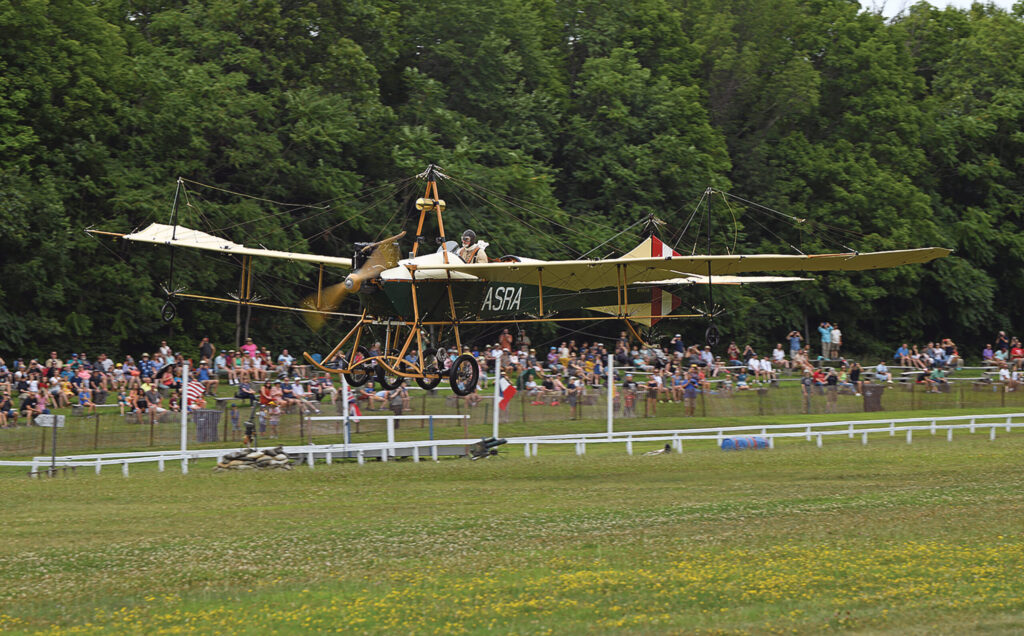
The beginnings of aerial combat sounded the death-knell of the military Taube, as speed and maneuverability began to assert their importance over stability. A few Lohner-built Etrich Taubessaw limited Austro-Hungarian service in the war’s first months, but by December 1914, when the Germans declared their Taubes “not usable for Front service,” the Austro-Hun-garians had already relegated them to the training role, where their forgiving flight characteristics were still a valuable asset. The Taube’s military career had been brief—but long enough for it to make its mark on aerial warfare.
After the war Igo Etrich lived in the Czechoslovak Republic, which included his native Bohemia. At an exhibition in Prague in 1926, he unveiled the Etrich VIII, also called the Sport-Taube, a high-wing, enclosed-cockpit monoplane whose only real connection to the old Taube lay in the flared tips of its cantilever-structure wings. During a flight in 1929, it managed a top speed of 93 mph with only a 45-hp Salmson radial engine. Nevertheless, it never went into production and Etrich abandoned development in 1931. (A flyable reconstruction of the Sport-Taube was completed in 1979 and can now be seen at the National Technical Museum in Prague-Kbely.) A final attempt by Etrich to use his Zanonia-seed wing resulted in a fanciful-looking, giant flying boat with three such wings in a tandem arrangement that he conceived in 1930, but it appeared in model form only.
World War II and its aftermath brought traumatic changes to Europe, including Czechoslovakia. In 1946, Etrich left the country to live in Bavaria. He moved to Freilassing near Salzburg, Austria, in 1950, and was made honorary president of the Austrian Aero-Club in 1954. In 1955, he became a naturalized West German citizen. Even at age 85, Igo Etrich often indulged his love of flying by going up in sailplanes, albeit as a passenger. He died in Salzburg on February 4, 1967, and was buried there. Appropriately, the tombstone was carved in the shape of his Taube.

